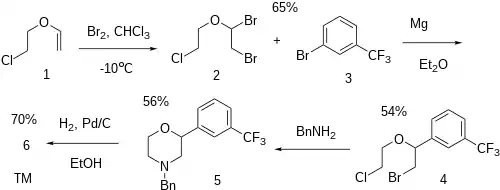Flumexadol
Flumexadol (INN) (developmental code name CERM-1841 or 1841-CERM) is a drug described and researched as a non-opioid analgesic which was never marketed.[1][2][3][4] It has been found to act as an agonist of the serotonin 5-HT1A (pKi = 7.1) and 5-HT2C (pKi = 7.5) receptors and, to a much lesser extent, of the 5-HT2A (pKi = 6.0) receptor.[5][6] According to Nilsson (2006) in a paper on 5-HT2C receptor agonists as potential anorectics, "The (+)-enantiomer of this compound showed [...] affinity for the 5-HT2C receptor (Ki) 25 nM) [...] and was 40-fold selective over the 5-HT2A receptor in receptor binding studies. Curiously, the racemic version [...], also known as 1841 CERM, was originally reported to possess analgesic properties while no association with 5-HT2C receptor activity was mentioned."[4] It is implied that flumexadol might be employable as an anorectic in addition to analgesic.[4] Though flumexadol itself has never been approved for medical use, oxaflozane (brand name Conflictan) is a prodrug of the compound that was formerly used clinically in France as an antidepressant and anxiolytic agent.[5][7][8]
 | |
| Clinical data | |
|---|---|
| ATC code |
|
| Identifiers | |
IUPAC name
| |
| CAS Number | |
| PubChem CID | |
| ChemSpider | |
| UNII | |
| Chemical and physical data | |
| Formula | C11H12F3NO |
| Molar mass | 231.218 g·mol−1 |
| 3D model (JSmol) | |
SMILES
| |
InChI
| |
Synthesis
Ex 1: Halogenation of 2-chloro ethyl vinyl ether [110-75-8] (1) with molecular bromine gives 1,2-dibromo-1-(2-chloroethoxy)ethane [14689-94-2] (2). Grignard reaction with 3-bromobenzotrifluoride [401-78-5] (3) gives 1-[2-Bromo-1-(2-chloroethoxy)ethyl]-3-(trifluoromethyl)benzene, CID:12343529 (4).
Ex 4: Treatment with benzylamine gives 4-benzyl-2-[3-(trifluoromethyl) phenyl]morpholine, CID:213531 (5).
Ex 6: Catalytric hydrogenation strips the benzyl protecting group completing the synthesis of flumexadol (6).
See also
References
- J. Elks (14 November 2014). The Dictionary of Drugs: Chemical Data: Chemical Data, Structures and Bibliographies. Springer. pp. 561–. ISBN 978-1-4757-2085-3.
- Hache J, Diamantis W, Sofia D, Streichenberger G (1978). "The pharmacology of 1841 CERM, a new analgesic". Arzneimittelforschung. 28 (4): 642–5. PMID 312104.
- Kucharczyk, N.; Yang, J. T.; Valia, K. H.; Stiefel, F. J.; Sofia, R. D. (1979). "Metabolites of 2-(3-Trifluoromethylphenyl)Tetrahydro-1,4-Oxazine (Cerm 1841) in Rats and Dogs". Xenobiotica. 9 (11): 703–711. doi:10.3109/00498257909042338. ISSN 0049-8254. PMID 532219.
- Nilsson, Björn M. (2006). "5-Hydroxytryptamine 2C (5-HT2C) Receptor Agonists as Potential Antiobesity Agents". Journal of Medicinal Chemistry. 49 (14): 4023–4034. doi:10.1021/jm058240i. ISSN 0022-2623. PMID 16821762.
- Jean-Pierre Bégué; Daniele Bonnet-Delpon (2 June 2008). Bioorganic and Medicinal Chemistry of Fluorine. John Wiley & Sons. pp. 303–. ISBN 978-0-470-28187-1.
- Leysen DC (February 1999). "Selective 5-HT2C agonists as potential antidepressants". IDrugs: The Investigational Drugs Journal. 2 (2): 109–20. PMID 16160946.
- J. Elks (14 November 2014). The Dictionary of Drugs: Chemical Data: Chemical Data, Structures and Bibliographies. Springer. pp. 909–. ISBN 978-1-4757-2085-3.
- Swiss Pharmaceutical Society (2000). Index Nominum 2000: International Drug Directory (Book with CD-ROM). Boca Raton: Medpharm Scientific Publishers. p. 766. ISBN 3-88763-075-0.
- Busch,N. et al. European Journal of Medicinal Chemistry, 1976 , vol. 11, p. 201 – 207.
- FR95182 idem Norbert Busch, Roland Yves Mauvernay,Jacques Moleyre, Jacques Simond, U.S. Patent 3,637,680 (1972 to Europ De Rech Mauvernay Sa Cen).
